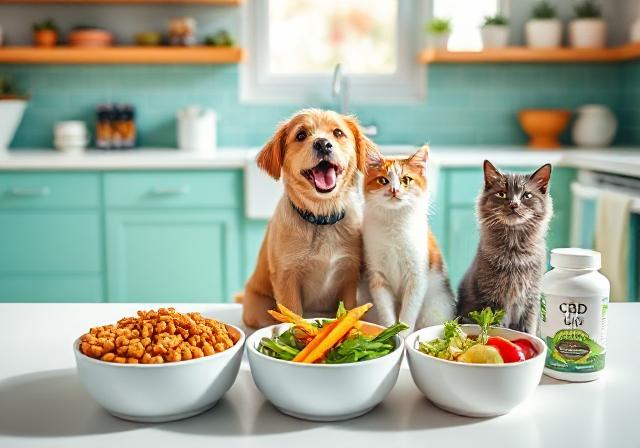Pet food aisles these days? Absolute chaos.
Raw. Kibble. Freeze-dried. Air-dried. Grain-free. Limited ingredient. And then you turn around and see TikTok videos of someone making gourmet salmon cakes for their cat.
And there you are… staring at a bag, trying to decipher if “chicken meal” is a nutritional powerhouse or a red flag (spoiler: it’s concentrated protein—perfectly safe!). Let’s hit pause and cut through the noise. We’ll break down what’s trending, what’s hype, and what actually helps your furry food critic thrive.
Pet Food Options: The Real Talk
1. Kibble (Dry Food)
The OG convenience champion. Think of it as the “fast food” of pet diets—but it doesn’t have to be junk.
- Pros: Cost-effective, shelf-stable (no refrigeration!), and dental benefits (crunching can reduce tartar). Quality brands offer complete nutrition.
- Cons: Low moisture (risk for dehydrated pets), carb-heavy in cheap formulas, and potential filler overload (soy, corn gluten).
- Pro Tip: Seek brands with AAFCO (Association of American Feed Control Officials) statements. Look for “complete and balanced for [life stage]” and named proteins (e.g., “deboned chicken,” not “poultry by-product”).
2. Wet Food (Canned/Pouched)
The savory, slurp-worthy comfort food.
- Pros: Hydration hero (70–80% water)—ideal for cats, kidney-conscious pets, or picky drinkers. Highly palatable and easy to digest.
- Cons: More expensive per calorie, spoils quickly (discard after 24–48 hours in the fridge), and can lack dental benefits.
- Pro Tip: Mix with kibble for balance: hydration + dental crunch. Check labels—some “gourmet” wet foods lack essential nutrients.
3. Raw Diet (The Polarizing Trend)
Unprocessed, ancestral-style eating—with fierce debate.
- Pros: Mimics natural diets, high bioavailability of nutrients, potential for shinier coats and energy boosts.
- Cons: Bacterial risks (Salmonella, E. coli) for pets and humans, nutritional imbalances if DIY’d, and time-intensive prep.
- Safety First: Commercial raw (freeze-dried/frozen patties) is safer—they’re irradiated or tested. Never feed raw to immunocompromised pets/humans.
4. Homemade Meals (DIY Chef Vibes)
Cooking for your pet? Heartwarming, but tread carefully.
- Pros: Total ingredient control (allergy-friendly!), no preservatives, and customizable for health conditions.
- Cons: Nutritional landmines! Calcium, taurine (for cats), and trace minerals are easily missed. Unbalanced diets cause deficiencies or toxicity.
- Golden Rule: Never wing it. Use a board-certified veterinary nutritionist (find one at ACVN.org) to formulate recipes.
Decoding the Bag: Ingredient Lists Made Simple
Pet food labels feel like chemistry class? Cut through jargon:
- Protein Power: First ingredient should be a named animal source (“beef,” “salmon,” not “meat”). “Meal” (e.g., “chicken meal”) is concentrated protein—not a filler.
- Red Flags: Vague terms like “animal by-products” (unidentified parts) or “artificial flavors/colors.”
- Carbs Context: Whole grains (oats, brown rice) offer fiber and nutrients—not evil! Avoid excess fillers (corn, wheat gluten) in low-quality foods.
- The “Short List” Myth: Shorter ≠ better. Some long lists include beneficial supplements (glucosamine, probiotics). Focus on quality of ingredients.

Supplements: Worth the Hype?
Food isn’t always enough. Smart supplements:
- Probiotics: Essential after antibiotics, for stress (moving, vet visits), or sensitive stomachs. Strains like Bifidobacterium boost gut immunity.
- Omega-3s (EPA/DHA): Fish oil reduces inflammation, supports brain/heart health, and eases arthritis. Flaxseed oil isn’t enough—dogs/cats convert it poorly.
- CBD: Emerging research shows promise for anxiety, pain, and seizures. Crucial: Use third-party tested, pet-specific products. Avoid THC.
- Multivitamins: Only if diet is deficient (e.g., homemade). Over-supplementing can harm! Ask your vet first.
The Big Question: Can My Pet Eat This? (Human Food Edition)
Stop Googling mid-snack! Key safety notes:
- Safe:
- Peanut Butter: Xylitol-free only (deadly for dogs).
- Pumpkin: Plain, cooked (not pie filling!) aids digestion.
- Carrots/Blueberries: Low-calorie, vitamin-rich treats.
- Toxic:
- Grapes/Raisins: Cause acute kidney failure in dogs.
- Onions/Garlic: Damage red blood cells (cats > dogs).
- Avocado: Persin (in skin/pit) = vomiting/diarrhea.
- Chocolate: Theobromine can kill. Dark = most dangerous.
- Proceed with Caution:
- Dairy: Many pets are lactose intolerant.
- Cooked Bones: Splinter and perforate intestines.
- Raw Eggs: Risk of Salmonella + biotin deficiency.

Pet Food Trends: Beyond the Hype
- Human-Grade: Meals made in USDA kitchens (e.g., The Farmer’s Dog). Pricey but transparent.
- Single-Ingredient Treats: Freeze-dried organs (liver, lung)—high reward, low processing.
- Personalized Plans: DNA tests + algorithms create custom meals (Nom Nom, PetPlate).
- Functional Foods: Kibble with baked-in glucosamine, calming herbs, or urinary health support.
The Vibe Shift: Food as Love Language
Feeding isn’t just sustenance—it’s trust, care, and bonding. Scatter kibble for mental stimulation. Hand-feed to build connection. Celebrate birthdays with a special (safe!) treat.
The best diet? The one that:
- Meets your pet’s biological needs (carnivore vs. omnivore!).
- Aligns with your budget and time.
- Your pet eats eagerly (no side-eye included).
FAQs
Q: Should I feed raw or cooked homemade meals?
A: Only with guidance from a vet nutritionist. Raw diets can be great but need to be balanced and handled safely.
Q: Do supplements replace good food?
A: Nope. Supplements are like accessories. The outfit (diet) still has to be solid.
Q: Are grain-free diets better?
A: Not necessarily. Some dogs do well with grains. Talk to your vet before cutting them out.
Q: Can I just give my dog leftovers?
A: Please don’t. Human meals often have seasonings, onions, garlic, and fats that can be toxic.
Q: What’s the safest treat?
A: Freeze-dried single-ingredient treats (chicken, fish) or plain pumpkin.
Q: Do grain-free diets cause heart disease?
A: Possibly. The FDA links some grain-free diets (high in peas/lentils) to dilated cardiomyopathy (DCM) in dogs. If concerned, choose grains like oats/rice and discuss with your vet.
Q: “My dog loves table scraps! Harmless, right?”
A: No. Human food is high-fat/salt, risking pancreatitis. Onions, garlic, and xylitol lurk in surprising places (sauces, sugar-free gum).

